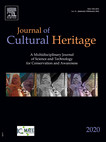 |
Helena P. Melo, António João Cruz, Sara Valadas, Ana Margarida Cardoso, António Candeias, "The use of glass particles and its consequences in late 16th century oil painting: the Portuguese case based on the analytical results and the technical treatises", Journal of Cultural Heritage, 43, 2020, pp. 261-270, doi:10.1016/j.culher.2019.11.001 |
| Abstract |
Colourless glass particles were identified for the first time in Portuguese paintings in two altarpieces attributed to the painter Francisco João, active between 1558 and 1595. They were found in red glazes with conservation problems. The glass was analysed by SEM-EDX and the binder by μ-FTIR. Portuguese 17th century painting treatises, which record earlier practices, were examined providing additional information. The glass particles had a vegetable silica-soda-lime composition, different in the two altarpieces, and a medium to very high alumina content. Although the provenance of the glass could not be determined, the use of local glass is suggested, as archaeological glass of the same period and similar composition has been found in southern Europe, notably Portugal. Furthermore, the glass from one of the altarpieces closely matches the composition of glass found in a painting by the Spaniard Luis de Morales. As a result, it is possible that the painter deliberately added a local glass to his red lakes, as advised in the two Portuguese painting treatises of this period. The exclusive presence of glass in the uppermost medium-rich glazes suggests that it was mainly used for its transparency and assumed siccative role. Although the siccative properties of glass have not been proved, by lowering the oil concentration in the paint, the addition of glass might have indirectly assisted the drying of the glazes. The glass particles were subject to a severe leaching of the alkali, a degradation that might explain the disruption of the glaze layers in these paintings. |
